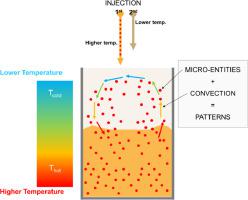Applied Materials Today ( IF 8.3 ) Pub Date : 2020-10-28 , DOI: 10.1016/j.apmt.2020.100859 Raphaël F. Canadas , Pedro Patrício , Virginia Brancato , Luca Gasperini , David Caballero , Ricardo A. Pires , João B. Costa , Hélder Pereira , Ping Yong , Lucília P. da Silva , Jie Chen , Subhas C. Kundu , Nuno A.M. Araújo , Rui L. Reis , Alexandra P. Marques , Joaquim M. Oliveira

|
Inducing thermal gradients in two injected fluid systems results in the temporal formation of mixing conductive streams. If preserved through sol-gel transition, this mechanism can be used to drive and pattern non-living and living entities in mixed hydrogels. Interfaces are vital in nature, where gradients of non-living and living entities build distinct yet continuous integrated living tissues. However, the common tissue fabrication methodologies often result in dissimilar interfaces, lacking continuity through the interfaced engineered tissues. Thus, there is an urgent need for the fabrication of heterotypic but continuous engineered tissues with spatial control over biomimetic features. Here, we demonstrate the influence of gel injection temperature on the patterning of gradients of non-living and living entities. The experimental part was confirmed by numerical modelling, showing the formation of convective lines which spatially drive microscale microparticle and cells when different temperatures are applied in the sequential injection of two gels. Based on this finding, pure gellan gum (GG) and blended GG with methacrylated gelatin (GelMA) systems were used to program the formation of gradient features in hydrogels, such as microparticle and cells distribution patterns, polymeric bioactivity, degradation, controlled release, and stiffness. The correlation between gel injection temperature and gradients formation can be applied to tissue interface modelling, regeneration, drug release systems, and broader materials engineering fields.
中文翻译:

水凝胶中非生物和生物微实体的对流模式梯度
在两个注入的流体系统中引起热梯度导致混合导电流的时间形成。如果通过溶胶-凝胶转变得以保留,则该机制可用于驱动和图案化混合水凝胶中的非生命和生物实体。界面在自然界中至关重要,在这里,非生命和生物实体的梯度构建了独特但连续的整合的生物组织。然而,常见的组织制造方法常常导致不同的界面,缺乏通过界面工程组织的连续性。因此,迫切需要制造具有仿生特征的空间控制的异型但连续工程组织。在这里,我们证明了凝胶注入温度对非生物和生物实体梯度构图的影响。实验部分通过数值建模得到证实,显示出对流线的形成,该对流线在顺序注入两种凝胶时施加不同温度时,在空间上驱动微米级微粒和细胞。基于此发现,使用纯吉兰糖胶(GG)和GG与甲基丙烯酸明胶(GelMA)系统共混来编程水凝胶中的梯度特征的形成,例如微粒和细胞的分布模式,聚合物的生物活性,降解,控释和刚性。凝胶注射温度和梯度形成之间的相关性可以应用于组织界面建模,再生,药物释放系统和更广阔的材料工程领域。图中显示了对流线的形成,该对流线在顺序注入两种凝胶时施加不同的温度,从而在空间上驱动微米级微粒和细胞。基于此发现,使用纯吉兰糖胶(GG)和GG与甲基丙烯酸明胶(GelMA)系统共混来编程水凝胶中的梯度特征的形成,例如微粒和细胞的分布模式,聚合物的生物活性,降解,控释和刚性。凝胶注射温度和梯度形成之间的相关性可以应用于组织界面建模,再生,药物释放系统和更广阔的材料工程领域。图中显示了对流线的形成,该对流线在顺序注入两种凝胶时施加不同的温度,从而在空间上驱动微米级微粒和细胞。基于此发现,使用纯吉兰糖胶(GG)和GG与甲基丙烯酸明胶(GelMA)系统共混来编程水凝胶中的梯度特征的形成,例如微粒和细胞的分布模式,聚合物的生物活性,降解,控释和刚性。凝胶注射温度和梯度形成之间的相关性可以应用于组织界面建模,再生,药物释放系统和更广阔的材料工程领域。纯的吉兰糖胶(GG)和GG与甲基丙烯酸明胶(GelMA)的共混物用于编程水凝胶中梯度特征的形成,例如微粒和细胞的分布方式,聚合物的生物活性,降解,控制释放和刚度。凝胶注射温度和梯度形成之间的相关性可以应用于组织界面建模,再生,药物释放系统和更广阔的材料工程领域。纯的吉兰糖胶(GG)和GG与甲基丙烯酸明胶(GelMA)的共混物用于编程水凝胶中梯度特征的形成,例如微粒和细胞的分布方式,聚合物的生物活性,降解,控制释放和刚度。凝胶注射温度和梯度形成之间的相关性可以应用于组织界面建模,再生,药物释放系统和更广阔的材料工程领域。



























 京公网安备 11010802027423号
京公网安备 11010802027423号